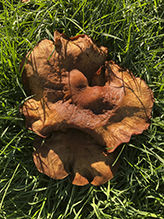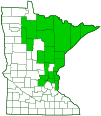False Chanterelle
(Hygrophoropsis aurantiaca)
Conservation • Description • Habitat • Ecology • Distribution • Taxonomy
Conservation Status |
|
|||||||
| IUCN Red List | not listed |
|||||||
| NatureServe | NNR - Unranked |
|||||||
| Minnesota | not listed |
|||||||
Description |
||
False Chanterelle is a colorful, medium-sized mushroom. It occurs in across Europe and North America, and in Japan, Australia, and Central America. In the United States it is common in the east and on the West Coast, less common in the Mountain States, and mostly absent from the Great Plains. In Minnesota it is common in the northeastern third of the state, absent from the remainder of the state. It is found from summer through fall; alone, scattered, in groups, or clustered; in deciduous, coniferous and mixed woodlands; usually under conifers. It usually grows on the ground on decaying forest litter (humus) and on woody debris. Occasionally it grows on well rotted wood. It is also found on roadsides and in yards growing on wood chips used for landscaping. False Chanterelle closely resembles Chanterelle, and this is the feature that gives the mushroom its common name. The cap is usually ¾″ to 3″ (2 to 8 cm) wide, but can be up to 5½″ (14 cm) wide. It is usually orangish-yellow to orangish-brown, darker and browner in the center, more orange or yellow at the margins. However, it can be any shade of yellowish-brown, orange, orangish-brown, or dark brown. Some are completely brown. It is convex with the margin rolled inward when young, becoming broadly convex, flat, or depressed in the middle at maturity. The upper surface is dry, soft, and velvety to the touch. The stalk is ¾″ to 3″ (2 to 8 cm) long and up to ⅜″ (1 cm) thick. It is usually centered, sometimes off-center; is often curved; and is equal in size at the top and base or slightly swollen at the base. It is dry and colored more or less like the cap. There is no fleshy ring on the stalk. The flesh is thin and whitish or tinged orange or a paler shade of the cap color. It is edible but should be avoided due to its close similarity to the poisonous Jack-o’-Lantern Mushroom. The gills are closely spaced, are usually forked repeatedly, and run down the stalk (decurrent). They are narrow but thin and have blunt edges. They are soft and usually deep orange to bright orange, sometimes pale orange. The spore print is white. |
||
Similar Species |
||
Chanterelle (Cantharellus cibarius) cap is more yellowish and is not dark in the center. It has thick, forked, decurrent, blunt-edged ribs and folds, not true gills. Jack-o’-Lantern Mushroom (Omphalotus illudens) gills are not forked and the gill edges are sharp, not blunt. It is poisonous. |
||
Habitat and Hosts |
||
Deciduous, coniferous and mixed woodlands, usually under conifers; roadsides and yards. |
||
Ecology |
||
Season |
||
Summer through fall |
||
Distribution |
||||
|
Sources |
|||
| 11/9/2021 | ||||
Occurrence |
||||
Common |
||||
Taxonomy |
|||
| Kingdom | Fungi (Fungi) | ||
| Subkingdom | Dikarya | ||
| Phylum | Basidiomycota (Basidiomycete Fungi) | ||
| Subphylum | Agaricomycotina (Higher Basidiomycetes) | ||
| Class | Agaricomycetes (Mushrooms, Bracket Fungi, Puffballs, and Allies) | ||
| Subclass | Agaricomycetidae | ||
| Order | Boletales (boletes and allies) | ||
Family |
Hygrophoropsidaceae | ||
Genus |
Hygrophoropsis | ||
Synonyms |
|||
Agaricus aurantiacus Cantharellus aurantiacus Clitocybe aurantiaca Merulius aurantiacus |
|||
Common Names |
|||
False Chanterelle |
|||
Glossary
Decurrent
Extending down the stalk from the point of attachment, as with leaf blades and mushroom gills.

Slideshows |
||

Visitor Videos |
|||
Share your video of this fungus. |
|||
| This button not working for you? Simply email us at info@MinnesotaSeasons.com. Attach a video, a YouTube link, or a cloud storage link. |
|||
Other Videos |
|||
| Identifying fungi. Hygrophoropsis aurantiaca - false chanterelle. Ashdown Forage |
|||
About
Oct 7, 2020 |
|||
| False Chanterelle (Hygrophoropsis aurantiaca) Find In Nature - mycology, fungi |
|||
About
Nov 25, 2020 Will I find any true Chanterelle? The False Chanterelle (Hygrophoropsis aurantiaca) was growing scattered everywhere in a forest of Pinus sylvestris. The main feature to tell the two species apart is the presence of true gills in the False one. Other differences between Chanterelle and False Chanterelle: - The cap of the edible Chantarelle (Cantharellus cibarius) is not usually darker at the center, its gills are false gills, the flesh is firm and white, and it has a fruity smell (like apricots). - The cap of the inedible Hygrophoropsis aurantiaca (False Chanterelle) darker at the center, its gills are true gills, the flesh is firm (sometimes the stalk is hollow), it's not white and it has a mildly mushroomy smell. 🔴 Subscribe for more mushrooms found in nature: https://www.youtube.com/channel/UCVP-... Twitter: https://twitter.com/FindInNature |
|||
| Chanterelle vs False Chanterelle Jamie Kunka |
|||
About
Aug 24, 2018 Hemp the dog and I set forth to discover the difference between the false and real Chanterelle. We take a few back to cook them into a supreme seasonal omelette. I am not a mycologist so please take care picking mushrooms for consumption and always consult and expert before trying anything. |
|||

Visitor Sightings |
|||||
Report a sighting of this fungus. |
|||||
| This button not working for you? Simply email us at info@MinnesotaSeasons.com. Be sure to include a location. |
|||||
: |
|
||||
MinnesotaSeasons.com Sightings |
|||||
|
|||||

Created: 11/9/2021
Last Updated:

